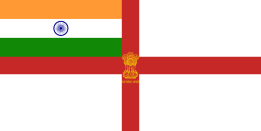INS Betwa (F39)
 Betwa docked at Mumbai Dock | |
| History | |
|---|---|
| Name: | INS Betwa |
| Namesake: | Betwa River |
| Commissioned: | 7 July 2004 |
| Status: | in active service |
| Badge: |
|
| General characteristics | |
| Class and type: | Brahmaputra-class guided missile frigate |
| Displacement: | 3850 tons full load |
| Length: | 126.4 m (414 ft 8 in) |
| Beam: | 14.5 m (47 ft 7 in) |
| Draught: | 4.5 m (14 ft 9 in) |
| Propulsion: | Two Bhopal turbines, 30,000 hp (22,000 kW), two 550 psi boilers and two shafts |
| Speed: | In excess of 30 knots (56 km/h; 35 mph) |
| Range: | 4,500 nautical miles (8,300 km; 5,200 mi) at 12 knots (22 km/h; 14 mph) |
| Complement: | 440-450 (incl. 40 officers + 13 aircrew) |
| Sensors and processing systems: |
|
| Armament: |
|
| Aircraft carried: |
|
INS Betwa (F39) is a Brahmaputra-class guided missile frigate currently in service with the Indian Navy. The ship is named for the Betwa River.
Operations
Operation Cactus
In 1988, following an attempted coup d'état against Maldivian President Maumoon Abdul Gayoom by Sri Lankan mercenaries, India launched Operation Cactus to restore the democratically elected government. After Indian paratroopers restored the presidency, the mercenaries captured Maldivian hostages on board a freighter and fled towards Sri Lanka. INS Godavari (F20) and INS Betwa successfully intercepted the freighter, rescued the hostages and arrested the mercenaries off the Sri Lankan coast.[1]
Operation Sukoon
Betwa was a part of Task Force 54, returning from the Mediterranean, when the 2006 Israel-Lebanon Conflict broke out. As a part of Operation Sukoon, Betwa participated in the evacuation of Indian citizens from Lebanon to Cyprus.
References
| Wikimedia Commons has media related to INS Betwa (F39). |
